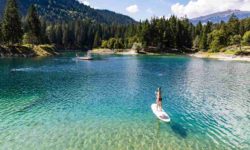As an Amazon Associate we earn from qualifying purchases.

Standup paddle boards are unique as a sports accessory each different type of paddleboarding. These boards are popularly known as SUP. Essentially, paddleboarding is a type of (sometimes flat water) surfing and it also first started in Hawaii.
When it comes to action, it is somewhat a combo of water surfing and kayaking. In this sport, paddlers stand on their board and move with the wave, like surfing, however they can catch waves earlier, and steer sharper with the help of a paddle that functions as propeller.
Sometimes known as flat water paddling, this water sport is enjoyed in rivers, lakes, oceans as well as in river rapids. Certain paddle boards are specifically used for each subset of the sport. Recently, paddle board yoga workout has also become quite popular.
Needless to say, different types of standup paddle boards are available in the market to cater to different paddling needs. If you are fond of the sport, then you need to learn about each of these types boards to enjoy the activity to the fullest.
All SUP board setups consist of three major components: shaft, blade, and handle. There are three types of standup paddle boards available. These are all-around, surf, and flatwater/race board.
Table of Contents
All-around boards
As the name suggests, an all-around board is decent at surf, flat water, or speed, but it likely gear towards beginners. These boards are often longer in size but thicker and wider as compared to other more specialized boards. Seasoned water sports enthusiasts call these boards versatile and multipurpose because they can be used for almost all types of paddling.
Because of the decent width and thickness, these boards are easy to stand on, easy to glide, and can be used for open ocean surfing as well as for paddling on flat water. Some of the all-round boards even come with a wind surf option, or kayak seat!
Advantages of using all-round boards
- Because of their light weight, these are easy to maneuver
- Compact design is an obvious convenience
- These boards are durable and quite sturdy – therefore, safe to use
- These boards are versatile
- Most suitable paddle boards for beginners
Surf Paddle Board
Surf boards are perfect for avid surfers who prefer to paddleboard in the ocean or in the river with a standing wave. These paddle boards are short in size and ideal for enjoying making rail to rail turns which is mostly not possible on flat water.
These boards are made with a pointed nose and a narrow tail. Because of its shape, it is easy to maneuver and and drop in on steeper angles (waves). These paddle boards are not as stable on flat water, and wouldn’t be much fun to paddle across a lake or anything.
Advantages of a surf style paddle board
- It is easy to maneuver because of its short size
- Perfect paddle board for avid surfers who already are comfortable in a swell
- Its narrow tail and pointed nose offer the ability to drop in and make sharp turns, ideal for catching waves.
Flatwater boards
As the name suggests, flatwater boards are meant for paddling on flat water. These boards are also good for paddling on small wavy surfaces such as gentle rivers. Because of their longer size, these boards are great for paddling longer distances, against the wind, with any gear, or with your doggy!
The pointed nose generally helps riders glide smoothly and maintain their speed while offering stability on the water surface at slower paddling speeds. Flatwater boards are available in a racing category too. Those are slightly longer in size and narrower in width. These boards are strictly for ace paddlers and not recommended for beginners, for their safety.
Advantages of using a flatwater board
- Best for using on flat water surface
- Because of pointed nose, it can move ahead in speed
- The round sides help in smooth gliding
- Available in normal and racing categories
How to select the best board type?
Now that you know about different types of standup paddle boards and their advantages, you need to select the best one for yourself according to your needs. If you want to buy a standup paddle board, you must have some plan for its usage. Here are a few general tips on buying the most suitable paddle board for yourself:
- Do you want to enjoy standup paddling on flat water? If yes, an all-round inflatable board will be the best option for you. If you love to fish or do yoga, then an all-round board is a good choice
- If you want to enjoy standup paddling in an ocean or bay, a surfing SUP is the best option for you.
- If you want to enjoy standup padding in a river, it is best to get an inflatable that super wide yet not too thick. It will help you stay stable and allow for easy maneuvering. Keep an eye out for smaller, pre-attached, river fins on a board.
Your level of experience
If you want to buy a paddle board for yourself, your experience paddling matters and you should purchase the board according to your level of expertise.
- For beginners, stability and safety matter the most. For them, all-round boards are always a better option. Start with an Inflatable SUP.
- If you are an experienced paddler and you love to surf ocean waves, the surf paddle boards are the best option for you.
- If you plan to do paddling in the river, or use it for fishing or yoga, flatwater boards will be good for you.
- If you are an experienced paddler and want to enjoy speed while paddleboarding, race boards are the best option for you
Now, knowing about the different types of stand up paddle boards is not enough. Apart from learning about these boards, you need to be aware of your personal level of expertise, the places where the board will be used, optimum weight of the board that you can easily maneuver, etc.
In fact, there is no set formula for buying the best SUP, but buy something that best suits your needs and have fun! That’s the most important thing.
Amazon and the Amazon logo are trademarks of Amazon.com, Inc, or its affiliates.

